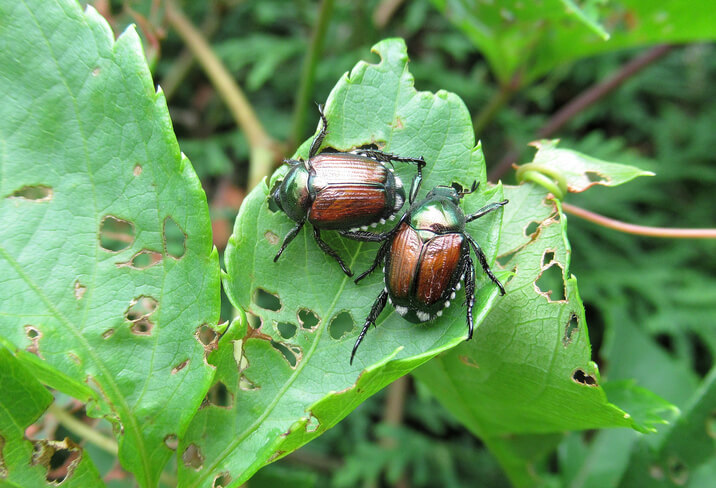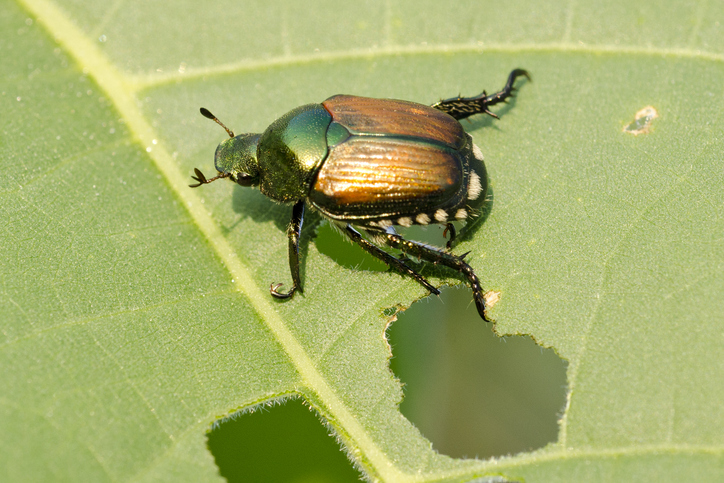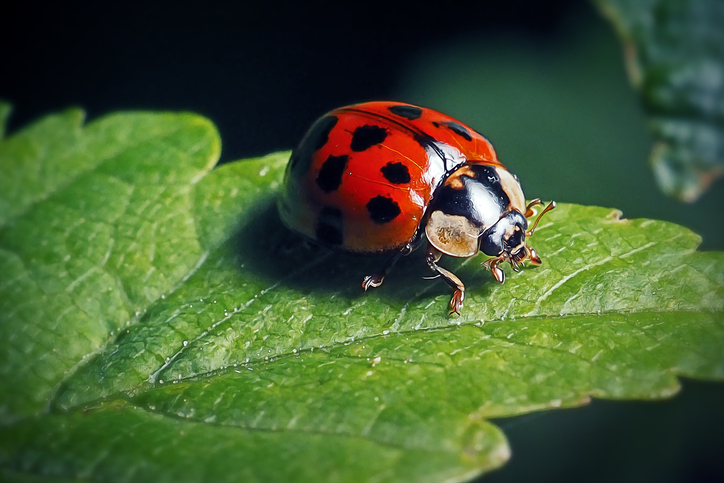Why You Need Professional Beetle Pest Control in Illinois
Humans aren’t the only species attracted to a warm and cozy home. Beetles regularly find their way into your home to find shelter and food, often slipping through open windows or even the smallest of cracks in your floorboards. Once they’ve found their way inside, you need to deal with them immediately with beetle pest control.
Neglecting a beetle infestation can damage your clothes, food, decor, and even your furniture. Depending on the species, they can even irritate your skin. Illinois experiences drastic changes in seasons that cause higher activity due to the summer heat or the need to flee into your home to survive the winter.
To avoid a beetle problem in your home, call American Pest Control. We’re your trusted, local solution for beetle pest control in Illinois.
What Are Beetles?
There are over 350,000 different species of beetle (and more are being discovered every day). While beetles come in different shapes, sizes, and colors, every beetle has shell-like wings, chewing mouthparts, and two antennae.
Knowing what beetles look like can help you keep beetles out of your home or garden for good. Plus, this knowledge can help professional exterminators know how to better target and remove these pests from your home.
The Types of Beetles We Treat in Illinois
We know it’s difficult to keep up with so many different types of beetles in Illinois. At American Pest Control, we provide both regional expertise and specialized knowledge about the unique behaviors of various beetles.
Below are some of the more common beetle species in Illinois, which are often the source of beetle pest control requests.

Carpet Beetles
This tiny beetle may not seem like much, but it earned its name for its fondness for chewing on wool carpets – but they don’t stop there. While the majority of carpets today are made out of synthetic fibers, they can still find a way into your home to chew on clothes, eat your food, or even nibble on stray hairs.
What Carpet Beetles Look Like
These dark brown beetles in Illinois are small and quite annoying when they gather in large numbers. If you’re not sure if you’re dealing with a carpet beetle, check out this visual description.
- Tan or Black Bands: If you peer closely, they can have tan or black bands around their body.
- Very Small: Carpet beetles are rarely bigger than one-fourth of an inch, sometimes even smaller.
- Grubs: Their larvae tend to be very tiny and a bright yellow-orange color. As they get bigger, their color darkens with heavy black stripes and more fuzz.
Noticed any black beetles in Illinois? There are also black carpet beetles, which tend to be slightly larger than the brown ones, but behave similarly.
Damage Caused by Carpet Beetles
Carpet beetles are not known to bite or sting humans. However, they tend to shed little hairs that can irritate your skin, leaving itchy rashes or bumps especially for those with allergies.
They’re infamous for chewing through clothes and furniture, particularly natural materials like cotton or wool. Even if you have a lot of synthetic fibers in your home, that still won’t be enough to protect you from an infestation. Humans naturally shed dead skin, oil, and dirt, and these tiny particles can stick on the carpet or clothes. Since these beetles are so tiny, even a little bit of human residue can become a filling meal.
Signs of a Carpet Beetle Infestation
You’ll know you’re dealing with a carpet beetle infestation if you see the following signs:
- Multiple beetles roaming throughout the house, especially in cloth-heavy areas.
- Tiny holes in your clothing, towels, rags, or cloth-based furniture.
- Fecal pellets (which are so small and pale you could confuse them for salt).
- Thinned down areas on your carpet or rug that weren’t there before.
Tips for Getting Rid of Carpet Beetles
Getting rid of carpet beetles means you need to starve them of their primary food source as much as possible. Regular vacuuming is one of the best ways to keep them at bay since you’re removing all the little bits of dead skin, lint, and hair they like to feed on.
If you have a traditional woolen carpet, you’ll need to go a step further and do steam cleaning. However, stubborn infestations should always be handled with professional carpet beetle pest control services.

Japanese Beetles
Japanese beetles are an invasive species. Originally from Japan, they arrived on the East Coast of the United States in the early 1900s and have slowly spread westward.
Although they don’t usually enter homes in large numbers, they’re a danger to yard plants and gardens.
What Japanese Beetles Look Like
You can recognize Japanese beetles by these features:
- Metallic Coloring: Their heads are a shiny metallic green, and their wing covers are copper-brown.
- Length: Each is about 1/3 to 1/2 an inch long.
- White Hairs: The sides of their bodies have two tufts of white hair near the front and five more near the back.
- Grubs: Their young are from 1/8 of an inch to one inch, shaped like the letter “C,” and have a tan head, white or cream bodies, and visible legs.
Damage Caused by Japanese Beetles
An infestation of Japanese beetles can do major damage to your garden, decorative plants, and/or crops, making beetle pest control a necessity to protect your investment. They eat about 300 different types of plants, including:
- Fruit trees, such as plum, cherry, and apple
- Linden trees
- Rose bushes
- Crabapple trees
- Crape myrtle trees
- Birch trees
Every year, Japanese beetles destroy crops in the Eastern and Midwestern United States. They ‘skeletonize’ leaves, which means they eat all the tissue in a leaf except the veins and leave only a skeleton behind. They also bite into fruits and flower buds.
Japanese beetle grubs eat the roots of grasses, killing them gradually and loosening soil. As a result, you might notice your grass turning off-color. As you water it, it may improve slightly for a time or not improve at all.
Separate patches may die, and the soil may feel like a sponge when you walk on it. Finally, you can pull up loose turf by hand to see grubs crawling underneath.
Long-Term Effects on Plants
If you have healthy older trees, they’ll likely survive an attack by Japanese beetles. Sadly, younger trees or other plants that were struggling to begin with are more susceptible to permanent damage.
A flowering plant like a rose bush won’t be completely killed by Japanese beetles, but they often destroy their flower buds.
If you have a garden or an orchard, your herbs, vegetables, and fruits can survive a small amount of damage. If the infestation continues too long, your plants may not be able to grow or produce as much food as you would like or expect.
What Are the Signs of a Japanese Beetle Infestation
If you have Japanese beetles on your property, you’ll see these signs:
- Leaves that have been reduced to skeletons while still on the plant.
- The presence of a single Japanese beetle, which often means there are others, because they send out a signal to attract other beetles while feeding.
- Japanese beetle grubs burrowing in your soil.
- Beetles on the ground under trees and bushes.
- Brown patches of grass and/or loose turf.
Tips for Getting Rid of Japanese Beetles
If you have rows of plants, you can protect them with row covers. These are often needed for about two months during the summer, starting in May or June, when Japanese beetles feed on plants. Be sure to let pollinators in, though, if you need them.
If they get through your row covers, you can pull the beetles off your plants by hand, dropping each one into a bucket of water and dishwasher detergent. You can also shake them off onto a cloth on the ground, then empty the cloth into the bucket.
Asian Lady Beetles
Asian lady beetles look almost the same as ladybugs, leading many to wonder why they would need beetle pest control to deal with them. As it stands, they’re actually a completely different species from Asia.
They also act differently, particularly by being a nuisance and a pest during the winter.

Appearance of Asian Lady Beetles
It’s easier to see the difference between a ladybug and an Asian lady beetle in Illinois when they’re side-by-side. The Asian variety is bigger and longer, as well as showing subtle differences:
- It may be yellow, red, orange, or tan.
- The white markings on its black head will be in a rough “M” shape, though this “M” can be thin or broken.
- It may or may not have black spots on its wing covers.
Behavior of Asian Lady Beetles
Asian lady beetles often stay in gardens, eating smaller insects such as aphids. This can be helpful because aphids damage plants. However, lady beetles can also become pests by:
- Settling on windows in large numbers.
- Scraping human skin if they land on you or your family members.
- Excreting a yellow liquid with a bad odor.
- Invading homes during the winter or spring.
How Asian Lady Beetles Enter Your Home
Watch out for Asian lady beetles if your home is near fields or woods. As the weather cools, they search for warm places to spend the winter. Unfortunately, they can also invade homes in the spring.
They may gather on your windows, doors, shingles, and siding, searching for ways to enter the home through the spaces around door frames or windows. They also like to enter attics and other areas you don’t use often. Once inside, they search for warm hiding places, high moisture areas, or areas with contrasting light or dark colors.
Dangers of Asian Lady Beetles in the Home
Asian lady beetle infestations are not extremely dangerous to most people, but they are a problem. Their excretions (which they use to drive away predators) smell terrible. They also smell bad if you step on them – and then you’ll track it through the house.
Plus, their excretion can leave a yellow stain on fabrics, carpets, or wallpaper. These stains become even more offensive and more extensive when the beetles gather on a warm surface or around an entry point in a wall.
Some people also have an allergic reaction to Asian lady beetles. This can happen when they release their excretion or when beetles die inside your home. Their carcasses can attract other pests that feed on them, too. These beetles will sometimes bite when they’re looking for food or moisture.
Tips for Getting Rid of Asian Lady Beetles
The fastest way to remove Asian lady beetles in Illinois is to suck them up with a vacuum cleaner. You shouldn’t try to pick them up because they will release their yellow excretion and stain your home.
Luckily, you can try to prevent them from entering your home in the first place by:
- Fixing any holes in your door and window screens, or installing new ones.
- Placing screens over any vents in your attic.
- Repairing cracks or holes in your walls.
- Sealing or plugging any spaces around your pipes and windows.
- Putting new weather stripping around your doors if you see gaps.
These small insects may have found a way into your home through an entry point you haven’t discovered. If they keep returning, contact American Pest Control, and we’ll use professional methods to locate the source, then eliminate the infestation.
How American Pest Control Removes Beetles Safely
We use a variety of safe and effective methods to remove beetles depending on their species, preferred habitat, and the severity of the infestation. Since beetles can come back later, we also emphasize preventative measures to make your home less appealing to pests.
If you want to learn more about how we do beetle pest control, contact us with your questions and concerns. We’re happy to help you with a solution!
How American Pest Control Removes Beetles Safely
We know how frustrating it is trying to remove beetles from your home with no success. American Pest Control is your one-stop shop for targeted, effective solutions that address the core behaviors of different beetle species.
Beetle pest removal can take anywhere from a few hours to a few days. However, you’ll feel much better once the pests are cleared out and your home is returned to its previous splendor.
We also provide seasonal pest control to stop infestations before they happen, particularly during the autumn months when beetle activity kicks up. Whether you’re noticing an influx of green beetles in Illinois or suspect you have a larval infestation in your garden, we’re ready to help.
See What Our Customers Are Saying
Solve Your Pest Control Problem for Good
If you have a beetle problem, don’t wait until it gets worse. American Pest Control regularly provides Illinois residents with targeted, effective beetle pest control services to keep homes clean and safe.
From black beetles in Illinois to Asian lady beetles, we’ll narrow down the most effective solution for your infestation type, budget, and seasonal needs. Reach out to us today so you can eliminate the infestation at the source and get back to your everyday life without worry.

